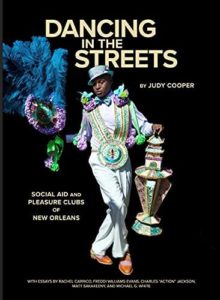 Sylvester Francis, the late founder of the Backstreet Cultural Museum, once described the experience of parading as a member of a social aid and pleasure club as feeling like “Cinderella Day.” Dressed in their finery, members of the clubs who come from all walks of life are transformed as they hit the streets strutting their stuff as “stars of the show.” Their pride, dignity, dedication, joy and fun jump out of the 300 very colorful photographs gathered in Dancing in the Streets – Social Aid and Pleasure Clubs of New Orleans, which accompanied an exhibition by the same name at The Historic New Orleans Collection. The historic black-and-white images from earlier decades, such as Jules Cahn’s 1970 shot of the Treme Sport, arguably speak of how little has fundamentally changed in the look of this 150-year tradition that was born in the Black neighborhoods of this city.
Sylvester Francis, the late founder of the Backstreet Cultural Museum, once described the experience of parading as a member of a social aid and pleasure club as feeling like “Cinderella Day.” Dressed in their finery, members of the clubs who come from all walks of life are transformed as they hit the streets strutting their stuff as “stars of the show.” Their pride, dignity, dedication, joy and fun jump out of the 300 very colorful photographs gathered in Dancing in the Streets – Social Aid and Pleasure Clubs of New Orleans, which accompanied an exhibition by the same name at The Historic New Orleans Collection. The historic black-and-white images from earlier decades, such as Jules Cahn’s 1970 shot of the Treme Sport, arguably speak of how little has fundamentally changed in the look of this 150-year tradition that was born in the Black neighborhoods of this city.
The book’s author, Judy Cooper, presents the bulk of the modern-day photos of the clubs, including 58 photographs that are accompanied by short biographies with well-researched information on when they were formed and by whom. Cooper chats with some club members who offer insights into their organization’s goals and purposes as benevolent associations and their anniversary parades. Ten other contemporary photographers were also called in for the project.
Essays on the second-line traditions, written by five contributors, range from the culturally historic roots of the practice to present-day stylings. Each brings deeper insight and understanding to the photographs. Rachel Carrico’s chapter, “The Dancing,” is appropriately lively as she describes “footwork” terms like buckjumping and stepping. She goes to the source, the club members, for the real feel of the improvisational nature of the dance moves and the forward movement of the line. The photos here are appreciatively on-the-street action shots.
Clarinetist Dr. Michael White, who as a youth first played on the streets with Doc Paulin’s Brass Band, takes a historical look at the brass bands—their sound, look, instrumentation and repertoire—in “The Music” chapter. The noted musician and educator brings things more up to date by mentioning the innovations made by brass bands such as the Dirty Dozen, Rebirth, New Birth, Hot 8, TBC and others. He stopped a little short leaving out some hot, much-in-demand bands like the Hot 6 Brass Band that have been very active in the last several (pre-pandemic) years. More kudos might also have been given to the Treme Brass Band that has been the incubator for so many musicians.
While “The Music” section of the book naturally boasts many photos of brass bands on the street both from the past and recent years, it could be observed that more were needed throughout the volume. After all, there is no second line without music.
The two chapters that make up the book’s “Epilogue” hold a certain sadness on several levels. Charles “Action” Jackson interviewed the movers and shakers of social aid and pleasure clubs for his article “The Year Without Second Lines,” referring to the impact of the shutdown caused by the pandemic. Jackson was involved in many aspects of the tradition but was perhaps best known as DJ Action Jackson on his “Takin’ It to the Streets” show on radio station WWOZ. His passing on August 8, 2021, was a great loss to the second line and Black Indian communities.
A tear might certainly be shed on reading Matt Sakakeeny’s moving “A Traditional Jazz Funeral for Alfred ‘Bucket’ Carter.” Carter, the heartbeat of the 137-year-old Young Men Olympian Jr. Benevolent Association, who joined the organization at the age of five, was its parade chairman and remained active until he reached 80 years of age. The author’s observations and Cooper’s photos take you to the celebration of his life.
The Sunday afternoon anniversary parades are by the people and for the people. On the pages of Dancing in the Streets – Social Aid and Pleasure Clubs of New Orleans we meet and see some of them on their joyful and colorful “Cinderella Day.”




